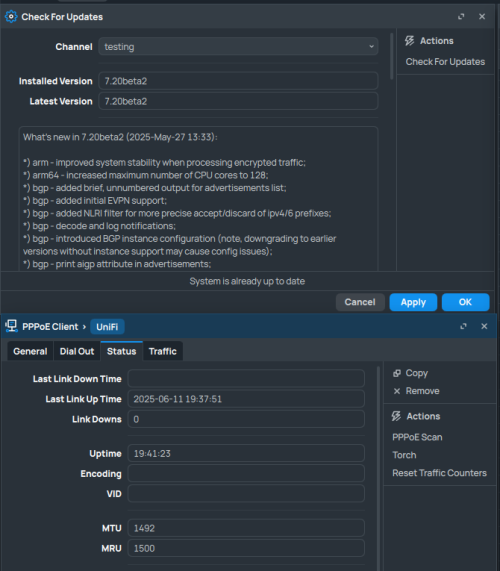QUOTE(winter01942 @ Jun 6 2025, 03:02 PM)
Greeting Sifus,
Am recently researching into running a IKEv2 VPN server for site-to-site and also for my android device to connect back to home network
However was not able to ping or reach public IP port UDP 500 & 4500 from the Internet even with all firewall filter deny rules temporarily disabled. With further digging I suspected CG-NAT? As the PPPoE link was on address 100.x.x.x but my public IP was 161.x.x.x
Any suggestions whether I should try to request for a public IP from TIME Internet, or we have reached the point where IPv6 makes sense now?
I would skip IKEv2 and use Wireguard on IPv6 instead.Am recently researching into running a IKEv2 VPN server for site-to-site and also for my android device to connect back to home network
However was not able to ping or reach public IP port UDP 500 & 4500 from the Internet even with all firewall filter deny rules temporarily disabled. With further digging I suspected CG-NAT? As the PPPoE link was on address 100.x.x.x but my public IP was 161.x.x.x
Any suggestions whether I should try to request for a public IP from TIME Internet, or we have reached the point where IPv6 makes sense now?
It works on more network.
It saves battery since you no longer need keep alive to maintain NAT session. I never turn off my Wireguard on phone and didn't get faster battery drain due to this one single change.
Option 1:
Use a DDNS provider like freedns.afraid.org.
Create a script to open the link.
Call the script from DHCPv6 client whenever the DCHP pool is updated.
Wireguard server runs on Mikrotik.
Option 2:
Can use Mikrotik DDNS but I never try this before since I already have a very elaborated setup before they introduce this feature.
If you just connect back to share file, Mikrotik Back To Home is just an app that abstract everything for very easy setup.
Option 3:
If you have a VPS anywhere, let that act as a Wireguard hub and everything else act as a spoke.
Benefit of this is low latency and you don't need to deal with the host of problem that comes with dynamic IPv6 prefix that infest TM.
You do need to configure each network manually in the Wireguard config.
Alternatively you can use orchestration tool like NetBird to help if you have a lot of spokes with a lot of network.
Option 4:
Use SaaS like Tailscale. Technically they are a Option 3 but it's their server instead of your server.
I never like setting my own VPN just to use third party service so I build Option 3 personally. Choose your own option, don't have to follow me.


 Jun 6 2025, 06:26 PM
Jun 6 2025, 06:26 PM

 Quote
Quote


 0.0214sec
0.0214sec
 0.32
0.32
 7 queries
7 queries
 GZIP Disabled
GZIP Disabled